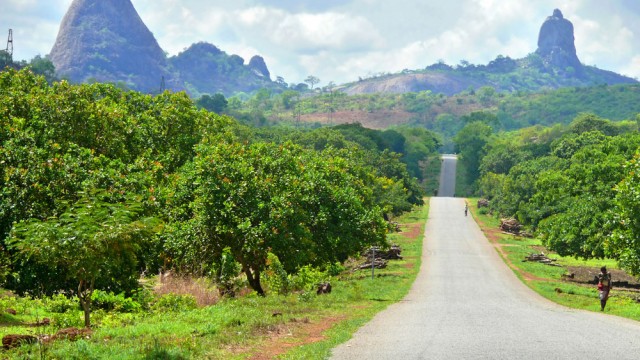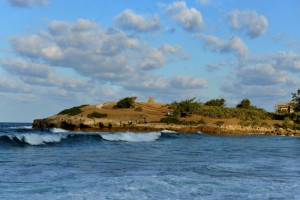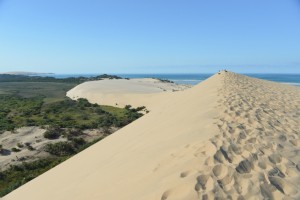Images of spicy prawns, dusty roads, stunning beaches and a distinct Portuguese flair motivate visitors to slog through the convoluted Mozambican immigration system in order to experience the magic for themselves.
After shelling out just under US$100 for a single-entry 30-day visa to an all-too-likely grouchy looking officer, you have made it. Now what?
To get started, these are some of the country’s most famous sights. Each slightly different from the next, these four destinations each appeal to a slight different demographic. Use one – or all – as an initial launching point into the country.
Ponto d’Ouro
This quiet beach town on the country’s southern border with South Africa (SA) is a magnet for vacationing South Africans. Leave SA’s tar roads behind as you cross the border into deep sand. Hurl yourself along the unmarked tracks with the aid of a GPS until you come across the ever-expanding beach town of ‘Ponto’. Owned almost entirely by South Africans, a visit here fills you with prawns, sunshine and delightful beach walks – without any of the hassles of really immersing yourself in Mozambique. English is often the language of choice and Rand the preferred currency. Dive sites are available, though snorkeling, swimming with dolphins, quad biking and parasailing are generally more popular activities. Sampling R&Rs – a local speciality cocktail – also inevitably occupies quite a bit of time.
Access: Ponto d’Ouro is only accessed in a private 4×4 vehicle. It is a few kilometers away from the Kosi Bay Border Post, and roughly 100 kilometers south of Maputo. Be warned that those 100km take over 3 hours to drive in a private vehicle, and far more if using public transport.
Tofo
This backpacker paradise rivals Ponto for popularity, but offers a distinctly more ‘Mozambican’ experience. A plethora of lodges offers a range of budget to mid-range options, with a few incorporating diving, yoga and surfing into the daily roster of activities. All dusty roads seem to lead to the central market, where a few key Portuguese words will help you navigate fresh produce, bread and seafood vendors as you prepare for a classic braii. Otherwise, a number of tasty and creative restaurants serve up classic local dishes with French, Thai and South African twists. The primary draw to the region is the opportunity to dive with the resident whale sharks and giant manta rays, though snorkel-based ocean safaris, surf lessons, and long walks down the sand-dune fringed beach are ever popular with the non-divers. Otherwise, look forward to lively nights filled with partiet a shame. airport sleepers. ured rity tnership between airlines and the managing for us budget sleepers – ith a new locations on the beach – particularly during a full moon.
Access: The nearest airport is in Inhambane, roughly 30km from Tofo. Flights connect the city with Maputo and Johannesburg almost daily. Tofo is roughly 500km from Maputo.
Vilankulo, Inhassoro and the Bazaruto Archipelago
300 kilometers north of Tofo are the slightly more upscale towns of Vilankulo and Inhassoro. With a number of all-inclusive lodges that cater well to families – and the stunning Bazaruto Archipelago just off shore – this is another popular beach paradise for vacationers. Diving and snorkeling in the archipelago are some of the most popular activities, though a passionate deep sea fishing community is emerging quickly as well. A leisurely sail on a local dhow is most certainly an essential experience, and the magic really sets in as the single sheet is lifted and the motor switched off. The towns themselves lack that quaint beach charm found in Tofo and Vilankulo, and the beaches on the continent are somewhat less idyllic. That said, when the tide moves out the ocean shifts through shades of deep blue and turquoise before eventually transforming into a sandy lunar-looking landscape. This daily rhythm consistently captivates guests.
Access: The nearest airport is found in the town of Vilankulo. It has flights that connect with Inhambane, Maputo and Johannesburg almost daily. Vilankulo is just over 700km north of Maputo.
Maputo
Not to be forgotten among the beachside towns is the country’s capital city of Maputo. In the 1960s, this city was heralded as the continent’s most cosmopolitan and fashionable city. Today, street side cafes spill out under the jacaranda-lined boulevards, providing a glimpse into the city’s former glory. A number of post-war reconstruction pains do of course remain, including electricity and water shortages, but with patience, this further adds to the charm. Spend your days in Maputo exploring fantastic art galleries and museums that feature local talent, and wander between architectural highlights. Be sure to visit the central train station, designed by an associate of the architect of the Eiffel Tower. Worth noting is that this station transforms into a club in the evenings, and pulses alongside the city’s vibrant nightlife.
Access: The country’s primary airport is located roughly 20 minutes outside the city center, and has a number of daily international flights. There is also easy road access to South Africa’s Komatipoort border.
Practical Considerations
Before you go to Mozambique for the first time, be sure to remember these 10 essential facts:
- It is a Portuguese speaking country. Tourism facilities speak varying degrees of English – and the more you pay the better staff English gets. Learning a few words will always serve you well.
- The national currency is the Metical (M). Its exchange rate is roughly M 30 to USD 1. The South African rand is generally accepted or exchanged, especially in the southern half of the country.
- The south is well traveled. The north is not. If you are looking for an easy and social trip, stay south. If you are seeking remoteness, fly or drive to the northernmost provinces.
- Malaria is prevalent. Prophylaxes are strongly recommended, particularly if you are spending time near the coast. Medical facilities in the country generally leave much to be desired.
- Prices are surprisingly high. Tourism is not especially well established or developed in Mozambique, and costs to travel and sleep often catch visitors off guard.
- The rainy season is very wet. If possible, it is preferable to visit during the drier months between May and September.
- It is a post-war country. Fighting ended in 1992 with a peace agreement, and democratic elections were held in 1994. In 2013, political tensions began to rise and the central Sofala province has since been precarious. The rest of the country is generally safe for travel.
- Immigration is a headache. It is best to organize your visa in advance with your local consulate – and don’t forget your yellow fever vaccination!
- South Africans love it. The primary travelers to Mozambique are South African vacationers. Escaping to her tropical shores is a perfect escape for a quick seafood and sun-filled break.
- It is fantastically unique. Portuguese influence, post-war development and copious amounts of seafood make Mozambique unlike any of her southern African neighbours. A visit here is always and interesting and delightful treat.




